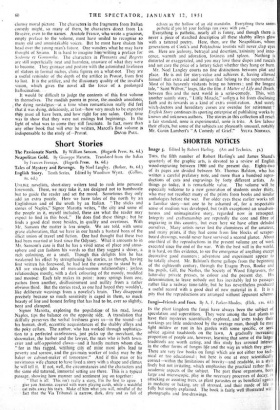SHORTER NOTICES
Image 5. Edited by Robert Harlin. (Art and Technics. cc)
Dim the fifth number of Robert Harling's and James Shand's quarterly of the graphic arts, is devoted to a review of English wood-engraving between 1900 and the present day. Eighty-two of its pages are divided between Mr. Thomas Balston, who has written a careful prefatory note, and more than a hundred repro- ductions of cuts and engravings by forty different artists. As
things go today, it is remarkable value. The volume will be especially welcome to a new generation of students under thirts, who may not recollect many of the prints from books and similar anthologies before the war. For older eyes these earlier works tell a familiar story—not one to be ashamed of, for a respectable sense of medium was developed, but (with exceptions) an unadven- turous and unimaginative story, regarded now in retrospect_ Integrity and craftsmanship are reputedly the core and fibre of engraving in this country, but even here we have often deluded ourselves._ Many artists never lost the clumsiness of the amateur. and many prints, if they had come fi lam line blocks of scraper- board drawings, would never have survived a second glance. About one-third of tin reproductions in the present volume are of work executed since the end of the war. With the best will in the world. it is hard, on this evidence, to see the emergence of anything except decorative good manners ; adventure and experiment appear to be totally absent. Mr. Balston's theme gallops from the beginning of the eighteenth century, through the Eragny Press, Rooke and his pupils, Gill, the Nashes, the Society of Wood Engravers, the latter-day private presses, to colour and the present day. His determination. to leave nobody out has inevitably led to passage, rather like a railway time-table, but he has nevertheless produceJ a useful record with a good deal of new material in it. It is a pity that the reproductions are arranged without apparent scheme.


































 Previous page
Previous page